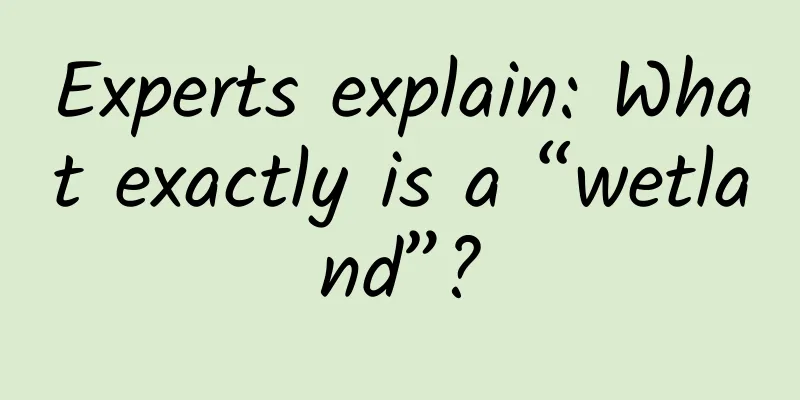Experts explain: What exactly is a “wetland”?

|
The 14th Conference of the Parties to the Convention on Wetlands, which concluded not long ago, has given us a deeper understanding of "wetlands". However, some people are still confused: What kind of land can be called a wetland? Are the Yellow River and the Yangtze River wetlands? Are the rivers and lakes in the parks around us wetlands? Are reservoirs wetlands? Sugan Lake Wetland in Aksai Kazakh Autonomous County, Jiuquan City, Gansu Province. (Photo by Gao Hongshan) According to experts, the "Wetland Protection Law of the People's Republic of China" was officially implemented on June 1 this year, which stipulates: "Wetlands as referred to in this Law refer to natural or artificial, perennial or seasonal waterlogged areas and waters with significant ecological functions, including sea areas with a water depth of no more than six meters at low tide, but excluding paddy fields and artificial waters and tidal flats used for aquaculture." This is the current authoritative interpretation of the definition of wetlands in my country. Experts said that, in simple terms, wetlands, as one of the three major ecosystems on Earth, cover almost all relatively fixed natural or artificial water bodies on land, as well as sea areas with a water depth of less than 6 meters at low tide. "Are the Yellow River and the Yangtze River wetlands? Are the rivers and lakes in the parks around us wetlands? Are reservoirs wetlands?" Obviously, the answer is: Yes, these are all wetlands! In my country, wetlands are vast coastal mudflats. The Red Beach Scenic Corridor in Panjin City, Liaoning Province. (Photo by Sun Xiaowei) Is a river that flows day and night— Yutouwan, Xiao Sanxia Scenic Area, Wushan County, Chongqing. (Photo by Wang Changzheng) It is a sea of lakes. Hequ Horse Farm in Maqu County, Gannan Tibetan Autonomous Prefecture, Gansu Province. (Photo by Xinhua News Agency reporter Chen Bin) A swamp with lush waterweed— The Dajiuhu National Wetland Park in Shennongjia, Wuhan, Hubei, has a variety of wetland types, including subalpine meadows, peat moss swamps, sleeping grass swamps, and moss swamps. (Photo by Xinhua News Agency reporter Xiao Yijiu) It is a water park nearby. Ganzhou City Central Park, Jiangxi Province. (Photo by Hu Jiangtao) As one of the three major ecosystems along with forests and oceans, wetlands silently protect and nourish billions of lives on Earth by maintaining biodiversity, conserving water resources, purifying water quality, responding to climate change, resisting disasters, and providing sustainable livelihoods, providing an important material and environmental foundation for human economic and social development and civilization progress. More than 40% of the world's species rely on wetlands to reproduce and thrive, so wetlands are also called "species gene banks" and have become hot spots for biodiversity conservation. The Oriental White Stork is a national first-class protected wild animal, known as the "Chinese Treasure Bird". (Photo by Li Zhonglin) my country's wetlands are widely distributed and rich in types, covering almost all wetland types covered by the Ramsar Convention. In recent years, under the guidance of Xi Jinping's ecological civilization thought, my country has comprehensively promoted wetland protection and restoration, with a wetland area of 56.35 million hectares. Among the 43 existing international wetland cities in the world, China has 13, ranking first in the world. Groups of elk are foraging and playing in Qinhu National Wetland Park, Jiangyan District, Taizhou City, Jiangsu Province. (Photo by Yan Yuming) Tan Guangming, deputy director of the State Forestry and Grassland Administration, said that the next step will be to continue to study and implement the spirit of the 20th National Congress of the Communist Party of China. By 2025, my country's wetland protection rate will reach 55%, with 20 new internationally important wetlands and 50 nationally important wetlands. By 2030, a high-quality development pattern of wetland protection will be initially established, and the wetland ecosystem functions and biodiversity protection will be significantly improved. The beautiful wetlands will make our home more harmonious and livable! |
Recommend
Weilai’s conference call indicated that the sharp decline in profit margins was mainly due to the recall of 4,803 ES8s.
On September 24, 2019, NIO released its second qu...
Customer acquisition and conversion methods: applicable to both e-commerce and knowledge payment
Recently many friends have asked me why other peo...
A 10,000-word research report on Xiaohongshu!
It took nearly 3 working days, and the content co...
Brand Marketing: Let posters arouse consumer power in 3 seconds
In response to the phenomenon that posters are th...
Three people started a wildfire by smoking in a forest area, concealed the fire and fled the scene
December 4, 14:40 Puning City, Guangdong Province...
The road to decoupling mobile Tmall
This article is a compilation of the author's...
Off-site traffic? 5 tips on how to create popular articles on Xiaohongshu!
How to write a popular article on Xiaohongshu? Th...
What do you know about the fig’s “fruit without flowers”?
"It has no gorgeous flowers, but it has swee...
Mobei Class SEO Course 9th VIP Course 10th Optimization SEO Course 2020 Synchronous 10th
The 9th session of SEO training has started, and ...
Gifts from the Deep Earth: Why are hot springs hot? What other uses does geothermal energy have?
Produced by: Science Popularization China Author:...
Apple makes an exception and allows employees to take unreleased prototypes home. The new iPhone is made entirely by remote control
During the COVID-19 pandemic, Apple made an excep...
1,100 new local infections! Omicron has another evolutionary branch, experts remind: This is crucial
From 0:00 to 24:00 on March 10, 555 new confirmed...
My practical experience in Android development
I have always wanted to write an article summariz...
Why must the freezing temperature of a refrigerator be set at minus 18 degrees?
Summer is here, and the weather is getting hotter...









